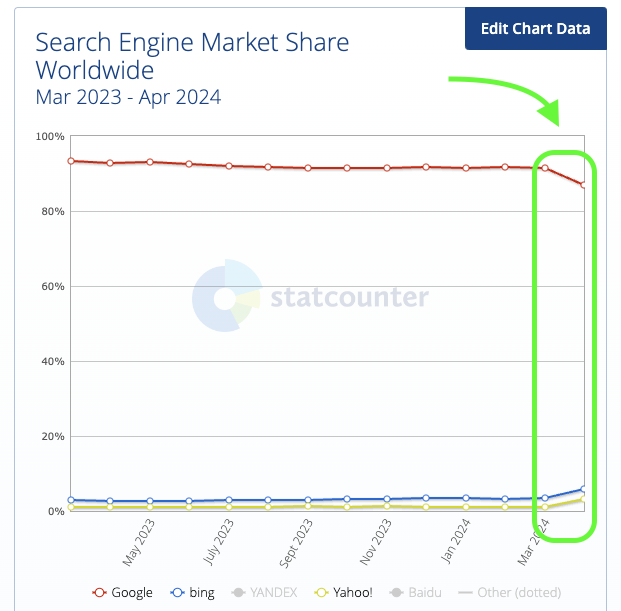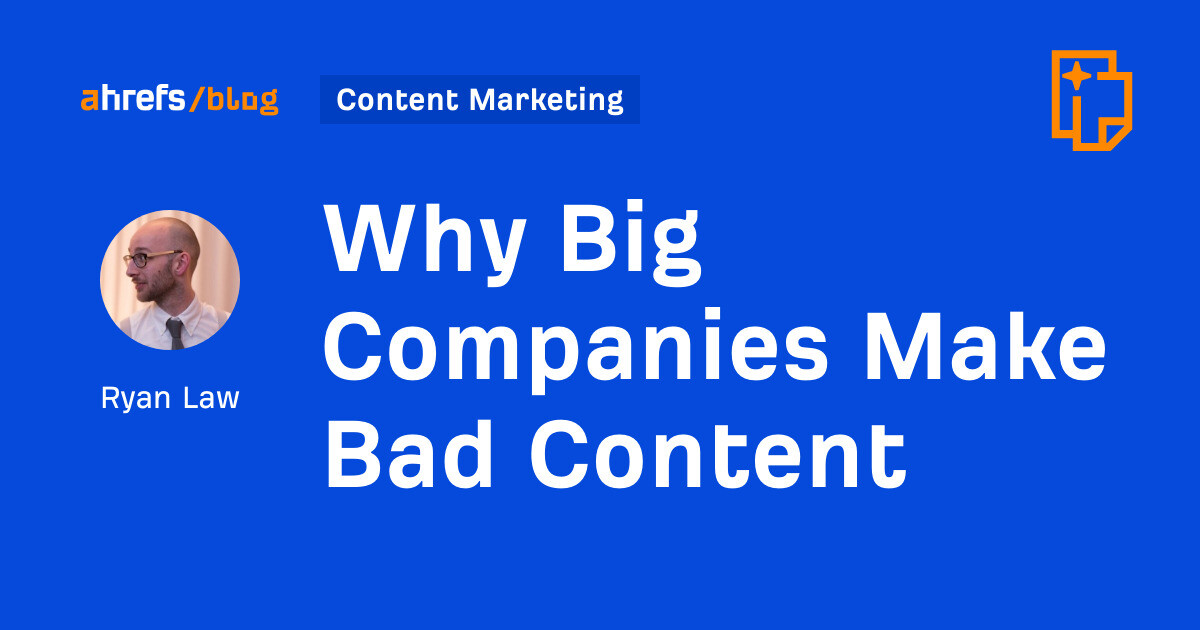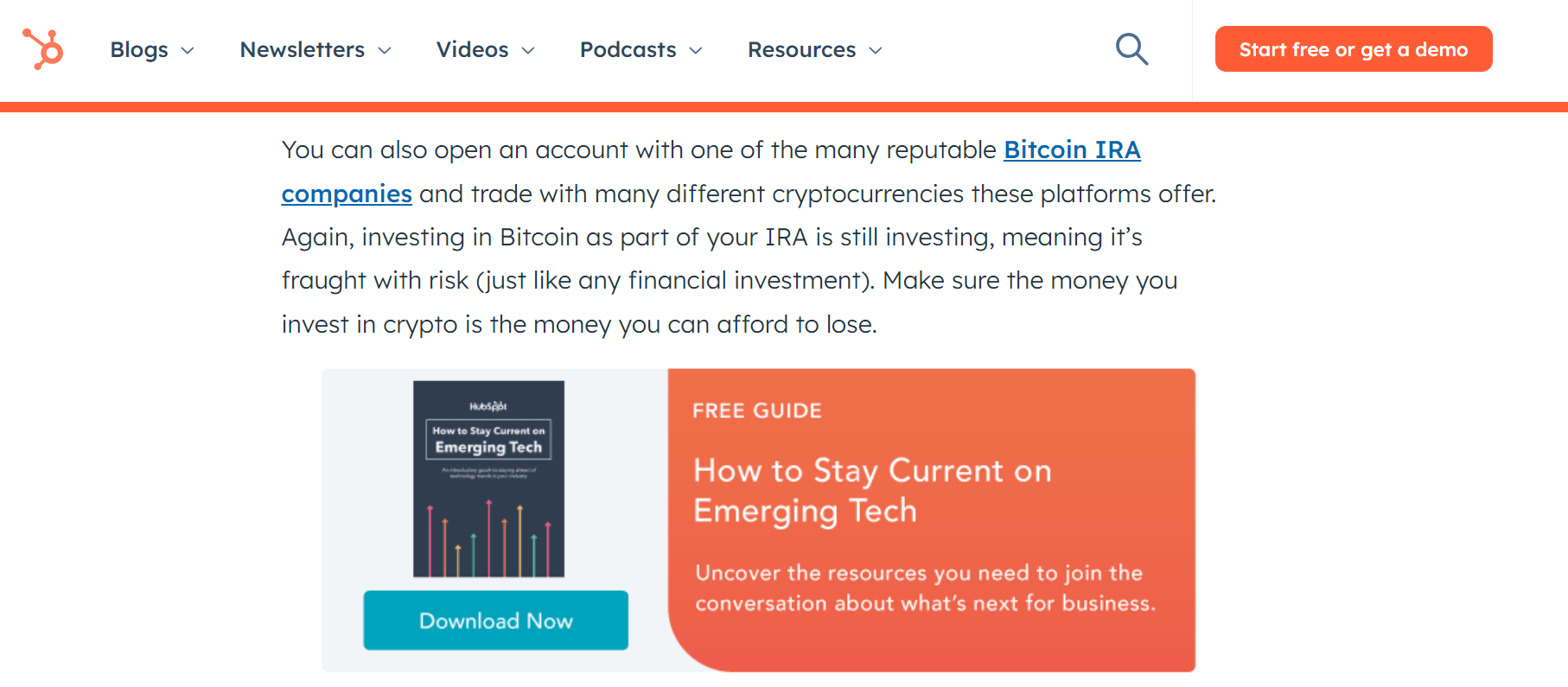SEO
12 Ways To Use Content Marketing To Build Brand Awareness

Content marketing continues to be one of the most powerful methods for driving targeted traffic and winning over new customers – and it shows no signs of slowing down in 2022.
In fact, new strategies seem to emerge every year, empowering more content producers to create more compelling and engaging content.
Traffic generation is only one of the many perks of content marketing, though. For new and growing brands, content can be a way to put themselves on the map. We’re talking about brand awareness.
Here’s how to use content marketing to drum up visibility for your brand and even attract new customers in the process.
What Is Brand Awareness, Really?
Brand awareness refers to the level at which consumers are familiar with your brand, goods, or services.
There are varying degrees of brand awareness, from simply having encountered a brand’s product to knowing and remembering a brand by name.
For new brands, simply getting their “foot in the door” is a starting point to acquiring more customers and increasing their visibility over time.
Advertisement
Continue Reading Below
Brand Awareness Influences Search
I’ve worked with many clients who have launched new brands and aren’t sure where to start when it comes to their brand awareness strategy. I always relay that brand awareness plays a role in search (meaning, Google search) and vice versa.
In that way, brand awareness is not at all removed from SEO.
Think about how social media trends influence users’ awareness of certain brands. We saw this with fidget spinners, which made their debut on social. Then, users flocked to Google in search of these toys.
Thus, we saw searches for “fidget spinners” increase… and then quickly decrease once fidget spinners fell out of vogue.
With this in mind, adopting a holistic content marketing strategy has the potential to increase Search visibility and drive organic traffic to your site. The more users are aware of your brand, the more they will search for you on Google.
Search Influences Brand Visibility
Likewise, using SEO to your advantage is one way to drive brand awareness. You may not yet have name recognition, but you can use non-branded search terms to drive users to your website.
Advertisement
Continue Reading Below
For example, say you just launched a new invoicing SaaS for business owners. Even though your brand name may not have Google searches yet, you can target terms like “small business invoicing software” or “how to create a business invoice” to attract users to your website.
Then, they will have their first encounter with your new brand.
What This Means For Your Brand
All of the above means that content marketing is essential to influence your organic traffic and drum up brand awareness.
Your content strategy should be at least two-fold in terms of creating content that gets your brand name out across platforms and in driving organic traffic to your site.
Content marketing can help your brand:
- Attract more followers on social media
- Generate social/referral traffic to your website
- Form strategic brand partnerships
- Improve the organic ranking of your website
- Earn high-authority backlinks to your site
- Improve customer retention over time
These are just a few of the many benefits of content marketing for brand visibility.
Now, let’s dive into how to make your content work for you – and turn your brand into a household name.
12 Content Marketing Tactics For Brand Awareness
As an SEO content strategist, I’m a huge fan of creating content that serves multiple purposes. With this in mind, the following strategies will not only help your brand awareness efforts but potentially increase your visibility and traffic on other platforms.
1. Research Your Target Market And Audience
Before you ever type a word of content, you should determine your target market and the ideal audience you want to reach with your brand.
Without this step, you risk creating the wrong type of content on the wrong platforms for the wrong audience – and wasting your time in the process.
Fortunately, market research has become far easier now that we have many tools at our disposal. My favorite is Google Forms, which you can use to survey potential audiences and gauge their interest in brands like yours.
Advertisement
Continue Reading Below
Here’s how to conduct quick and easy market research:
Create Google Form with the following questions:
- What is your #1 struggle when it comes to [primary topic of brand]?
- What solutions have you tried already to solve this problem?
- What issues did you have with those solutions?
- If you were to define your ideal solution, what would it be?
- What are you hoping to accomplish by [solution]?
Then, use your social channels, existing email list, network, and other communities you have access to.
Survey people in your potential audience. Aim to get 10+ responses.
Tally up the most common responses from your survey.
Finally, use the insights to inform your brand message and who your ideal customers may be.
Over time, I recommend using tools like Google Analytics to track real performance and better hone in on who is engaging with your content.
In the meantime, however, an initial survey will help ensure you are operating based on audience input, not your own assumptions.
2. Define Your Brand’s Unique Selling Proposition
In order to stand out in your market, you need to define something unique that your brand brings to the marketplace.
Advertisement
Continue Reading Below
This may be a more efficient way to solve a customer problem, a more affordable solution, better customer service, or a range of what we call unique selling points.
Your unique selling proposition (USP) is a statement that highlights your brand’s key selling points and frames them in a way that communicates value to your target audience.
For example, it’s too general to say you are a marketer who offers marketing services. A USP such as, “X Agency offers bespoke digital marketing services to help brands grow with scale, precision, and confidence.” This is where the real gold is.
Your USP will become the foundation of all of your marketing efforts. It will be what sets you apart in the marketplace, attracts your ideal customer, and defines why consumers should buy from you.
3. Create Non-Branded, Searchable Web Content
At this stage, very few people may know about your brand, particularly on a brand-name basis. This is where you can use non-branded search to your advantage in order to drive traffic to your website.
Advertisement
Continue Reading Below
Maybe you have a local clothing boutique that just opened in Seattle. While people may not be aware of your storefront yet – unless they happen to walk by – you can still use SEO to drive traffic both online and off. In this case, some terms to target may be:
- [downtown seattle clothing store] which has around 320 searches per month.
- [vintage clothing store seattle] which has around 260 searches per month.
- [womens clothing seattle] which has around 20 searches per month.
You can then optimize your website content – web pages, primarily – according to these search terms. If done well, you can drive new users to your website and even your local listings (like Google Business Profiles).
Advertisement
Continue Reading Below
4. Forge Strategic Industry Partnerships
Getting your foot in the door as a new startup or business often requires forming close partnerships with other business owners. Never underestimate the power of referrals and word-of-mouth marketing.
While in-person networking will certainly serve these interests, your content marketing can as well. Here are a few ways to use content to build industry partnerships:
- Publish thought leadership content on LinkedIn and form new connections.
- Join Facebook groups and share insights with other industry professionals.
- Host a Facebook Live or other live chat to grow your following.
- Post informative video content and engage with other business owners in the comments.
- Conduct email outreach to form third-party publishing opportunities.
- Invite business owners to contribute to or be interviewed on your blog.
The benefits of forging these partnerships are plenty. For one, you can create a wide network of referrals for your business. Second, you can bank on the authority and reach of other businesses to share your content.
This is an activity that should be ongoing as long as you want to drive more brand awareness.
5. Publish On Third-Party Websites
If you have a new business, chances are your website lacks the authority to really push your content to the top of the Google search results.
Advertisement
Continue Reading Below
This has much to do with the age of your domain, your backlink history, and how much optimized content you have on your site.
Fortunately, you can use other websites’ authority and influence to boost your own. Here’s how this works:
- Create a list of industry-related websites which may be likely to publish your content (think: small businesses, not Forbes).
- Reach out to the publisher or business owner via email asking if you can contribute blog content on a periodic basis. Specify that this is not for linking purposes, but to share your industry experience.
- Once accepted, write content on topics that your audience would find valuable (again, keep your USP in mind). However, avoid being self-promotional.
- Share this content with your growing audience. See the results of publishing your content on larger platforms.
“Guest posting”, as this is called, is particularly helpful if you have a very small audience. With guest posting, you can get more eyes on your experience, content, and, eventually, brand.
6. Capitalize On Influencer Marketing
Similar to the above, you can use influencer marketing to reach a wider audience. This is particularly common for ecommerce brands, which engage with influencers to share and promote their products.
Find influencers in your industry who may be interested in shouting out your brand. This may be in exchange for free products or other incentives. If they accept, this can be a good way to grow your following.
Advertisement
Continue Reading Below
7. Let Data Drive Your Content
The success of your content marketing relies on using data to drive your content. The “publish and pray” method hardly works as a true strategy. Hence why we begin your content plan with audience research.
There are many tools you can use to help you interpret user data and use this to inform your content strategy. Some of these tools include:
- Google Analytics – for performance insights, user demographics, and user behavior.
- Google Search Console – for keyword performance, click-through rate, and positioning.
- SEMRush – for keyword research, competitor analysis, content analysis, and backlinks reports.
- Hootsuite – for social media engagement, impressions, and brand awareness.
I suggest monitoring these tools on a weekly basis to see how your platforms are currently performing, what content is driving the most awareness of your brand, and how users are engaging with content on your website.
8. Diversify Your Content Strategy
When you are first starting out, it’s nearly impossible to know which platforms and which types of content will resonate most with your target audience.
Advertisement
Continue Reading Below
Truly, you will need to diversify your content strategy to see which strategies have the most impact on your particular brand.
Really, your content should serve the purpose of communicating your values as a business. This relates back to your USP, as defined in Step 2.
Then, you can use different types of content to engage your audience:
- Videos.
- Blog articles.
- Podcasts.
- Infographics.
- Social media posts.
- Live videos.
- Guest posts.
- Interviews.
- Tutorials.
- Email campaigns.
- Paid ads.
- Hosted events.
Over time, your analytics will reflect which types of content users engage with most. This will give you direction on what content to publish most often, and which types to nix from your content strategy.
9. Utilize Social Listening Tools
Sentiment analysis uses machine learning to essentially “listen” to conversations users are having online and determine how people are talking about your brand. This can be highly valuable, as it allows you to see whether your brand is being portrayed in a positive light (or not).
Advertisement
Continue Reading Below
More than that, it gives you the opportunity to own the narrative. Tools like Brandwatch may empower you to see what has people buzzing, but your content will be what shapes the conversation over time.
The new age of consumer intelligence has allowed many brands to get ahead of the curve, shift the perspective, and drum up more awareness online.
10. Establish A Content Publishing Strategy
Based on your audience research, data analytics, and social listening insights, you may now know what to publish – but actually getting the content out there is a different story. Building brand awareness is often a fragile time where messaging and consistency really make the difference.
If you are lax on your publishing schedule, you may miss out on opportunities to drum up brand awareness. If you are inconsistent in your messaging, you may confuse your audience about what your brand is about.
Establishing a publishing schedule – with outlined topics and dates – will help keep you accountable for creating content on a regular basis. Plus, you will have a record of what you’ve published already so you don’t duplicate your efforts in the future.
Advertisement
Continue Reading Below
11. Own Branded And Non-Branded Conversations
It’s tempting to try and be the sole voice regarding your brand, but you should be present in non-branded conversations as well.
- Are you sharing your knowledge on certain industry topics?
- Are you asking users what they are interested in or what they are struggling with?
- Are you weighing in on recent trends?
The goal here is to keep your finger on the pulse of what’s happening in your industry, not just your business. The more you’re able to “talk shop” with your audience, the more chances you give them to encounter your brand.
12. Don’t Forget The Follow-up
Once your content is out there, you give your audience many opportunities to come across your brand. But you can just as easily fall off their radar. This is where the follow-up matters.
This may include:
- Following up with email subscribers via email.
- Running retargeting ads to website visitors.
- Initiating conversations with your social media followers.
- Following up with existing customers.
- Responding to comments and messages.
- Checking in with your professional contacts and partners.
Advertisement
Continue Reading Below
Don’t let users encounter your brand once and then never see you again. A robust content marketing strategy engages users at multiple touchpoints and grows this engagement into a relationship that can evolve into a paying customer.
Content Marketing Insights To Grow Your Brand
When many business owners think of “brand awareness”, they think of publishing content on social media and hoping users take notice. But your content strategy can be much more, well, strategic, when you use insights to your advantage.
Audience research, keyword research, competitor analysis, and website analytics can all be used to inform your content strategy. That way, you are sure to reach the right users with the right content at the right time – and keep your brand top of mind until they are ready to buy.
More resources:
Advertisement
Continue Reading Below
Featured Image: Natasa Adzic/Shutterstock
SEO
Google’s Search Engine Market Share Drops As Competitors’ Grows

According to data from GS Statcounter, Google’s search engine market share has fallen to 86.99%, the lowest point since the firm began tracking search engine share in 2009.
The drop represents a more than 4% decrease from the previous month, marking the largest single-month decline on record.
U.S. Market Impact
The decline is most significant in Google’s key market, the United States, where its share of searches across all devices fell by nearly 10%, reaching 77.52%.
 Screenshot from: https://gs.statcounter.com/search-engine-market-share/, May 2024.
Screenshot from: https://gs.statcounter.com/search-engine-market-share/, May 2024.Concurrently, competitors Microsoft Bing and Yahoo Search have seen gains. Bing reached a 13% market share in the U.S. and 5.8% globally, its highest since launching in 2009.
Yahoo Search’s worldwide share nearly tripled to 3.06%, a level not seen since July 2015.
 Screenshot from: https://gs.statcounter.com/search-engine-market-share/, May 2024.
Screenshot from: https://gs.statcounter.com/search-engine-market-share/, May 2024.Search Quality Concerns
Many industry experts have recently expressed concerns about the declining quality of Google’s search results.
A portion of the SEO community believes that the search giant’s results have worsened following the latest update.
These concerns have begun to extend to average internet users, who are increasingly voicing complaints about the state of their search results.
Alternative Perspectives
Web analytics platform SimilarWeb provided additional context on X (formerly Twitter), stating that its data for the US for March 2024 suggests Google’s decline may not be as severe as initially reported.
From our data (Search Engine website category, US, March 2024) it doesn’t look like we’re there yet: pic.twitter.com/RBUJp4ZLeb
— Similarweb (@Similarweb) May 1, 2024
SimilarWeb also highlighted Yahoo’s strong performance, categorizing it as a News and Media platform rather than a direct competitor to Google in the Search Engine category.
Don’t underestimate Yahoo. They’re doing great. On our platform they’re categorized as News and Media, and hence not a direct competitor to Google in the Search Engine category. But they rank #10 worldwide, #6 in the US, and #1 in their category. Much higher than Bing and OpenAI. pic.twitter.com/O4yJu5QEK6
— Similarweb (@Similarweb) May 2, 2024
At the same time, Google is slightly declining 👀 pic.twitter.com/9i7paeU1QG
— Similarweb (@Similarweb) May 2, 2024
Why It Matters
The shifting search engine market trends can impact businesses, marketers, and regular users.
Google has been on top for a long time, shaping how we find things online and how users behave.
However, as its market share drops and other search engines gain popularity, publishers may need to rethink their online strategies and optimize for multiple search platforms besides Google.
Users are becoming vocal about Google’s declining search quality over time. As people start trying alternate search engines, the various platforms must prioritize keeping users satisfied if they want to maintain or grow their market position.
It will be interesting to see how they respond to this boost in market share.
What It Means for SEO Pros
As Google’s competitors gain ground, SEO strategies may need to adapt by accounting for how each search engine’s algorithms and ranking factors work.
This could involve diversifying SEO efforts across multiple platforms and staying up-to-date on best practices for each one.
The increased focus on high-quality search results emphasizes the need to create valuable, user-focused content that meets the needs of the target audience.
SEO pros must prioritize informative, engaging, trustworthy content that meets search engine algorithms and user expectations.
Remain flexible, adaptable, and proactive to navigate these shifts. Keeping a pulse on industry trends, user behaviors, and competing search engine strategies will be key for successful SEO campaigns.
Featured Image: Tada Images/Shutterstock
SEO
How To Drive Pipeline With A Silo-Free Strategy

When it comes to B2B strategy, a holistic approach is the only approach.
Revenue organizations usually operate with siloed teams, and often expect a one-size-fits-all solution (usually buying clicks with paid media).
However, without cohesive brand, infrastructure, and pipeline generation efforts, they’re pretty much doomed to fail.
It’s just like rowing crew, where each member of the team must synchronize their movements to propel the boat forward – successful B2B marketing requires an integrated strategy.
So if you’re ready to ditch your disjointed marketing efforts and try a holistic approach, we’ve got you covered.
Join us on May 15, for an insightful live session with Digital Reach Agency on how to craft a compelling brand and PMF.
We’ll walk through the critical infrastructure you need, and the reliances and dependences of the core digital marketing disciplines.
Key takeaways from this webinar:
- Thinking Beyond Traditional Silos: Learn why traditional marketing silos are no longer viable and how they spell doom for modern revenue organizations.
- How To Identify and Fix Silos: Discover actionable strategies for pinpointing and sealing the gaps in your marketing silos.
- The Power of Integration: Uncover the secrets to successfully integrating brand strategy, digital infrastructure, and pipeline generation efforts.
Ben Childs, President and Founder of Digital Reach Agency, and Jordan Gibson, Head of Growth at Digital Reach Agency, will show you how to seamlessly integrate various elements of your marketing strategy for optimal results.
Don’t make the common mistake of using traditional marketing silos – sign up now and learn what it takes to transform your B2B go-to-market.
You’ll also get the opportunity to ask Ben and Jordan your most pressing questions, following the presentation.
And if you can’t make it to the live event, register anyway and we’ll send you a recording shortly after the webinar.
SEO
Why Big Companies Make Bad Content

It’s like death and taxes: inevitable. The bigger a company gets, the worse its content marketing becomes.
HubSpot teaching you how to type the shrug emoji or buy bitcoin stock. Salesforce sharing inspiring business quotes. GoDaddy helping you use Bing AI, or Zendesk sharing catchy sales slogans.
Judged by content marketing best practice, these articles are bad.
They won’t resonate with decision-makers. Nobody will buy a HubSpot license after Googling “how to buy bitcoin stock.” It’s the very definition of vanity traffic: tons of visits with no obvious impact on the business.
So why does this happen?
There’s an obvious (but flawed) answer to this question: big companies are inefficient.
As companies grow, they become more complicated, and writing good, relevant content becomes harder. I’ve experienced this firsthand:
- extra rounds of legal review and stakeholder approval creeping into processes.
- content watered down to serve an ever-more generic “brand voice”.
- growing misalignment between search and content teams.
- a lack of content leadership within the company as early employees leave.


Similarly, funded companies have to grow, even when they’re already huge. Content has to feed the machine, continually increasing traffic… even if that traffic never contributes to the bottom line.
There’s an element of truth here, but I’ve come to think that both these arguments are naive, and certainly not the whole story.
It is wrong to assume that the same people that grew the company suddenly forgot everything they once knew about content, and wrong to assume that companies willfully target useless keywords just to game their OKRs.
Instead, let’s assume that this strategy is deliberate, and not oversight. I think bad content—and the vanity traffic it generates—is actually good for business.
There are benefits to driving tons of traffic, even if that traffic never directly converts. Or put in meme format:


Programmatic SEO is a good example. Why does Dialpad create landing pages for local phone numbers?


Why does Wise target exchange rate keywords?


Why do we have a list of most popular websites pages?


As this Twitter user points out, these articles will never convert…
…but they don’t need to.
Every published URL and targeted keyword is a new doorway from the backwaters of the internet into your website. It’s a chance to acquire backlinks that wouldn’t otherwise exist, and an opportunity to get your brand in front of thousands of new, otherwise unfamiliar people.
These benefits might not directly translate into revenue, but over time, in aggregate, they can have a huge indirect impact on revenue. They can:
- Strengthen domain authority and the search performance of every other page on the website.
- Boost brand awareness, and encourage serendipitous interactions that land your brand in front of the right person at the right time.
- Deny your competitors traffic and dilute their share of voice.
These small benefits become more worthwhile when multiplied across many hundreds or thousands of pages. If you can minimize the cost of the content, there is relatively little downside.
What about topical authority?
“But what about topical authority?!” I hear you cry. “If you stray too far from your area of expertise, won’t rankings suffer for it?”
I reply simply with this screenshot of Forbes’ “health” subfolder, generating almost 4 million estimated monthly organic pageviews:


And big companies can minimize cost. For large, established brands, the marginal cost of content creation is relatively low.
Many companies scale their output through networks of freelancer writers, avoiding the cost of fully loaded employees. They have established, efficient processes for research, briefing, editorial review, publication and maintenance. The cost of an additional “unit” of content—or ten, or a hundred—is not that great, especially relative to other marketing channels.
There is also relatively little opportunity cost to consider: the fact that energy spent on “vanity” traffic could be better spent elsewhere, on more business-relevant topics.
In reality, many of the companies engaging in this strategy have already plucked the low-hanging fruit and written almost every product-relevant topic. There are a finite number of high traffic, high relevance topics; blog consistently for a decade and you too will reach these limits.
On top of that, the HubSpots and Salesforces of the world have very established, very efficient sales processes. Content gating, lead capture and scoring, and retargeting allow them to put very small conversion rates to relatively good use.


Even HubSpot’s article on Bitcoin stock has its own relevant call-to-action—and for HubSpot, building a database of aspiring investors is more valuable than it sounds, because…
The bigger a company grows, the bigger its audience needs to be to continue sustaining that growth rate.
Companies generally expand their total addressable market (TAM) as they grow, like HubSpot broadening from marketing to sales and customer success, launching new product lines for new—much bigger—audiences. This means the target audience for their content marketing grows alongside.
As Peep Laja put its:
But for the biggest companies, this principle is taken to an extreme. When a company gears up to IPO, its target audience expands to… pretty much everyone.
This was something Janessa Lantz (ex-HubSpot and dbt Labs) helped me understand: the target audience for a post-IPO company is not just end users, but institutional investors, market analysts, journalists, even regular Jane investors.
These are people who can influence the company’s worth in ways beyond simply buying a subscription: they can invest or encourage others to invest and dramatically influence the share price. These people are influenced by billboards, OOH advertising and, you guessed it, seemingly “bad” content showing up whenever they Google something.
You can think of this as a second, additional marketing funnel for post-IPO companies:


These visitors might not purchase a software subscription when they see your article in the SERP, but they will notice your brand, and maybe listen more attentively the next time your stock ticker appears on the news.
They won’t become power users, but they might download your eBook and add an extra unit to the email subscribers reported in your S1.
They might not contribute revenue now, but they will in the future: in the form of stock appreciation, or becoming the target audience for a future product line.
Vanity traffic does create value, but in a form most content marketers are not used to measuring.
If any of these benefits apply, then it makes sense to acquire them for your company—but also to deny them to your competitors.
SEO is an arms race: there are a finite number of keywords and topics, and leaving a rival to claim hundreds, even thousands of SERPs uncontested could very quickly create a headache for your company.
SEO can quickly create a moat of backlinks and brand awareness that can be virtually impossible to challenge; left unchecked, the gap between your company and your rival can accelerate at an accelerating pace.
Pumping out “bad” content and chasing vanity traffic is a chance to deny your rivals unchallenged share of voice, and make sure your brand always has a seat at the table.
Final thoughts
These types of articles are miscategorized—instead of thinking of them as bad content, it’s better to think of them as cheap digital billboards with surprisingly great attribution.
Big companies chasing “vanity traffic” isn’t an accident or oversight—there are good reasons to invest energy into content that will never convert. There is benefit, just not in the format most content marketers are used to.
This is not an argument to suggest that every company should invest in hyper-broad, high-traffic keywords. But if you’ve been blogging for a decade, or you’re gearing up for an IPO, then “bad content” and the vanity traffic it creates might not be so bad.
-

 WORDPRESS6 days ago
WORDPRESS6 days ago9 Best WooCommerce Multi Vendor Plugins (Compared)
-

 SEO6 days ago
SEO6 days agoGoogle March 2024 Core Update Officially Completed A Week Ago
-

 MARKETING5 days ago
MARKETING5 days agoNavigating the Video Marketing Maze: Short-Form vs. Long-Form
-

 SEARCHENGINES6 days ago
SEARCHENGINES6 days agoGoogle March 2024 Core Update Finished April 19, 2024
-
![The Current State of Google’s Search Generative Experience [What It Means for SEO in 2024] person typing on laptop with](https://articles.entireweb.com/wp-content/uploads/2024/04/The-Current-State-of-Googles-Search-Generative-Experience-What-It.webp-400x240.webp)
![The Current State of Google’s Search Generative Experience [What It Means for SEO in 2024] person typing on laptop with](https://articles.entireweb.com/wp-content/uploads/2024/04/The-Current-State-of-Googles-Search-Generative-Experience-What-It.webp-80x80.webp) MARKETING6 days ago
MARKETING6 days agoThe Current State of Google’s Search Generative Experience [What It Means for SEO in 2024]
-

 SEO7 days ago
SEO7 days agoGoogle Declares It The “Gemini Era” As Revenue Grows 15%
-
SEARCHENGINES5 days ago
Daily Search Forum Recap: April 26, 2024
-

 WORDPRESS6 days ago
WORDPRESS6 days agoNew WordPress.com Themes for April 2024 – WordPress.com News
















You must be logged in to post a comment Login